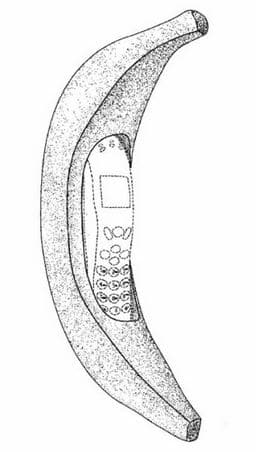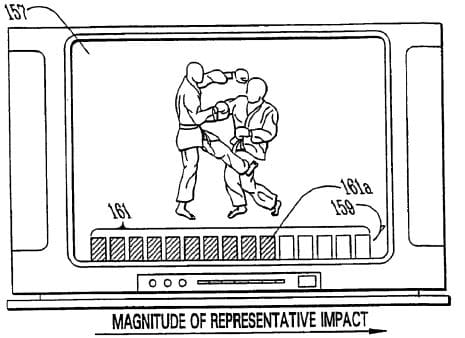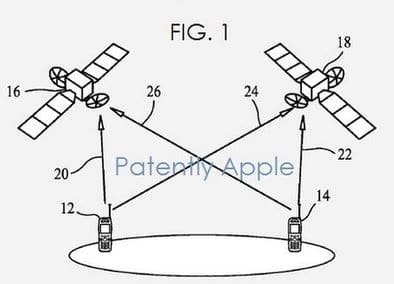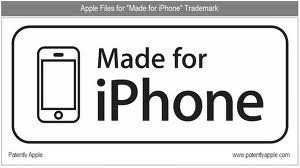 The first MFi Hearing aid post promised “an Alice in Wonderland hearing device tour of Amazing Apple Applications.” Before starting today’s tour, let’s check out one invention hanging around outside the Apple gate.
The first MFi Hearing aid post promised “an Alice in Wonderland hearing device tour of Amazing Apple Applications.” Before starting today’s tour, let’s check out one invention hanging around outside the Apple gate.
The Banana Cellular Phone Cover (patented 8/08/06), pictured right, is “characterized by elongated curving shape resembling a banana,” according to inventor James Laird Rickard. If nothing else, it provides Audiologists with a much needed logical explanation for the I-can’t- hear you-I’ve-got-a-banana-in-my-ear joke.
Back to the tour. MFI hearing aids are a tiny part of the Apple MFi program, which is breathtaking in scope. Apple applied for two trademarks for MFi badges, one of which is shown at the top of this post. As one website wag commented, Apple’s new motto is “There’s a trademark for that.”
Amazing Apple Apps
There’s also a patent for that — you name it, Apple’s thought of it, trademarked it and filed a patent application. Go to Apple’s Magnificent New Round of Manufacturing Process Patents and prepare to be amazed at what they’ve thought of that you haven’t. Imagining the new Apple-World of tomorrow is mind-blowing, including the new world of hearing devices. The following are just a few applications to consider.
Is That a Hearing Aid or a Banana in Your Ear?
 Hearing aid compatible iPhones can answer that question, thanks to US patent application #20130034234 (filed February 7, 2013). The phones will
Hearing aid compatible iPhones can answer that question, thanks to US patent application #20130034234 (filed February 7, 2013). The phones will
“automatically determine whether or not the device is being used by a hearing impaired user who is wearing a hearing aid.”
Once it finds the hearing aid, this app calculates the distance from phone to the hearing aid and automatically selects between normal audio or hearing aid compatible mode of operation.
And, speaking of bananas, why can’t the app be modified to calibrate the ear canal space and perform real ear measurements? And also detect unusual barriers like bananas or cerumen in the canal? I’ll bet there’s an app for that.
I Can’t Hear You, I Have a Hyperlink in My Ear
iPhones of the future will receive “audible or inaudible audio hyperlinks” sent from multiple sources once US patent application 20130204413 (filed August 8, 2013) is approved. Expect to “hear” from concert venues, podcasts, TV shows, and stores as they promote deals of the moment through audiolinks.
Imagine participating in e-learning through your Smartphone and jumping to links of interest as you listen and choose, much as we do currently when we read a blog and click on the links provided. Listeners will click, double-click to go to a link, and triple-click to return to the original audio stream. This takes audio multi-tasking to a new level, especially when driving.
It’s a baby step to imagine this in MFi hearing aids in which the programming button will navigate the audio hyperlinks.
Where’d I Put My Hearing Aid?
 Apple applied for a wearable “sensing systems monitoring” apps device back in 2009 and updated it on June 13, 2013 (US patent application 20130151699). It’s a wearable computer, perhaps in the form of a wristwatch or adhesive strip, which allows the wearer to locate and identify personal items such as hearing aids, car keys, maybe bananas if they’re on sale at the store.
Apple applied for a wearable “sensing systems monitoring” apps device back in 2009 and updated it on June 13, 2013 (US patent application 20130151699). It’s a wearable computer, perhaps in the form of a wristwatch or adhesive strip, which allows the wearer to locate and identify personal items such as hearing aids, car keys, maybe bananas if they’re on sale at the store.
Wearers can monitor personal health and fitness measures (e.g., heart monitor) and wireless transmissions of sensed data from other people and events in remote locations (e.g., televised boxing match). The June update to the application makes the computer-sensor-transmitter arrangement more specific, and of more interest to future MFi hearing aid applications:
The invention specifically relates to sensing and reporting events associated with movement, environmental factors … and changing conditions. …. providing …at least one of: a visual output; an auditory output; and a tactile output.
It’s a small step to imagine the stylish, pseudo wristwatch or scopalamine strip whispering sweet nothings about one’s heart, the weather, the stock market, the weird guy following you, the boxer’s utterances, whatever, into one’s MFi hearing aids. All while you’re driving and navigating audio hyperlinks. You’ll feel like you’re captain of the Starship Enterprise.
Dial Me Up Scottie
 Communications satellites orbit earth and there’s an app for that as of February 28, 2013. Mobile-to-satellite links aren’t new but Apple’s app applies the idea to all radio frequency communication links “irrespective of the direction of the information transfer.”
Communications satellites orbit earth and there’s an app for that as of February 28, 2013. Mobile-to-satellite links aren’t new but Apple’s app applies the idea to all radio frequency communication links “irrespective of the direction of the information transfer.”
Check out the patent application diagram, suggesting that even in household situations, distance and walls are no longer communication barriers if we elect to communicate with each other via satellite, bodyworn computers, ear level receivers and/or MFi hearing aids.
It’s only a step from satellite phones to cell phones traveling the same RF waves. And it’s one more step to MFi hearing aids “calling” friends and associates via satellite or receiving monitoring information from remote locations/people, or the spouse in the next room.
Is That a Hearing Aid in Your Ear or an Apple By-Product?
We’ll finish the tour back where we started, with US Patent Application #20130272555, which picks up where the first app ended: in hearing aid compatible mode if a hearing aid is detected. The phone uses noise cancellation technology (there’s an app for that) and t-coil technology to produce an acoustic output without feedback and a magnetic signal for use with a hearing aid t-coil. Here are the steps as I got them from reading the app (engineers, please comment and correct!):
- The iPhone creates a primary magnetic field signal consisting of the audio signal but not the “anti-noise signal.” That is coupled to the t-coil of the hearing aid.
- The iPhone also creates a by-product magnetic field signal (audio signal + anti-noise signal), which is weaker than the primary magnetic field signal.
- The stronger primary magnetic field signal “drowns out” the weaker by-product magnetic field signal
Ta Da! Hearing aid users can have it both ways as the iPhone produces:
“the desired audio content acoustically, while at the same time producing the desired anti-noise for acoustic coupling (e.g., when an iPhone is being held against the user’s ear in a handset mode of operation), but at the same time also avoid the unnecessary inductive coupling of anti-noise into a hearing aid that is operating in its T-coil mode.”
End of the Tour, if Not the Line
This is great, not only for those with hearing loss but anybody who wants to hear on the phone in background noise, by one means or another. But not everyone wants to purchase expensive hearing aids for that purpose.
Since the iPhone is going to do all the heavy lifting, why not design a simple ear-level device that contains an acoustic receiver and a t-coil? Let’s call it a PSAP, not a hearing aid. And, while we’re at it, why don’t we get Apple to put a mic on that iPhone or on the sensing systems monitor to pick up acoustic signals in the near environment, run them through an A/D converter on the iPhone and send them to our ear level devices? There must be an app for that, right? Oh right, Apple already has a mic and there’s an app for that. And there are audio-connectivity apps for hearing loss.
And once we’ve got that done, why not have the iPhone and sensing systems monitor work together to measure hearing, design fitting algorithms to modify incoming signals (acoustic or electronic), and send those to ear level receivers? And we didn’t even get into Apple’s voice recognition app, which is sure to solve spousal issues of all sorts.
No more hearing aids, no more PSAPs, just Apple. Is Apple hiring Audiologists? Perhaps somebody needs to alert the FDA as they struggle to redefine hearing aids and PSAPs.







